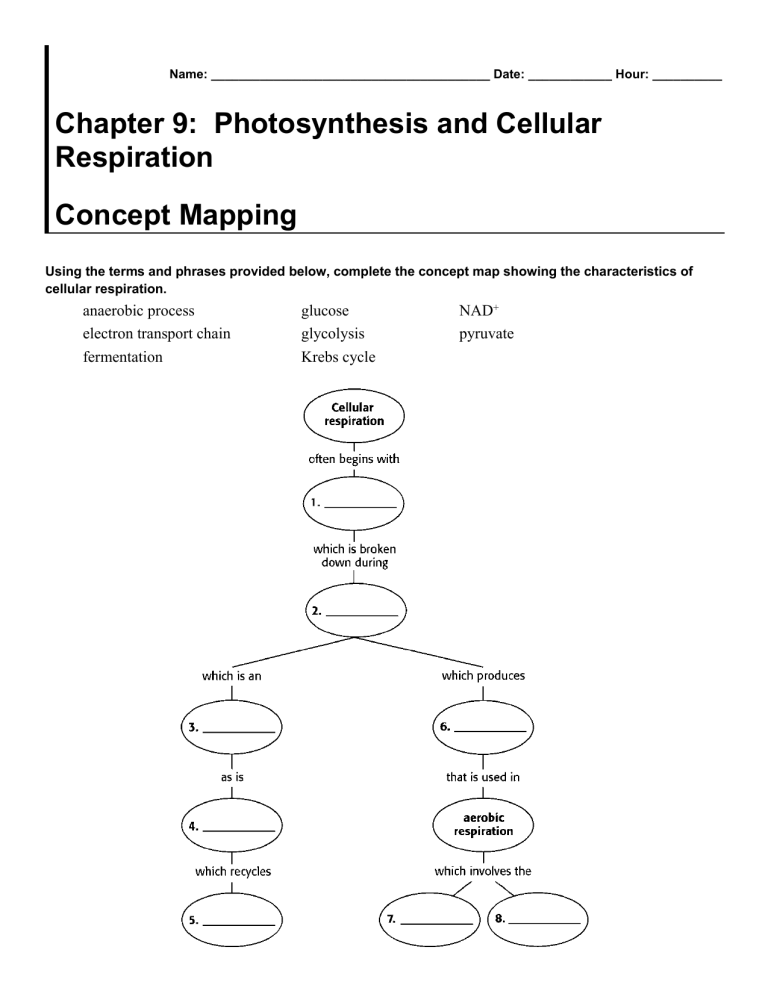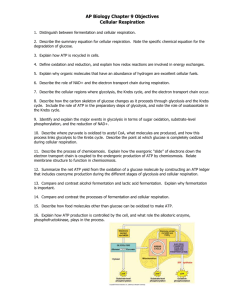Chapter 9: Photosynthesis and Cellular Respiration Concept Mapping

Name: ________________________________________ Date: ____________ Hour: __________
Chapter 9: Photosynthesis and Cellular
Respiration
Concept Mapping
Using the terms and phrases provided below, complete the concept map showing the characteristics of cellular respiration. anaerobic process glucose NAD + electron transport chain glycolysis pyruvate fermentation Krebs cycle
Chap 9 - Vocabulary Review
Write the correct term from the list below in the space next to its definition. aerobic cellular respiration Krebs cycle anaerobic chlorophyll photosynthesis
ATP
ATP synthase
Calvin cycle electron transport chain pigment fermentation glycolysis thylakoid
_____________________ 1. the process some organisms are able to use by which they convert light energy to chemical energy
_____________________ 2. the main method photosynthesizing organisms use for carbon dioxide fixation
_____________________ 3. a set of chemical reactions that break down pyruvate, producing electron carriers for an electron transport chain that powers ATP production
_____________________ 4. the process cells use to produce energy from carbohydrates
_____________________ 5. a substance that absorbs some wavelengths of light and reflects others, giving something its color
_____________________ 6. the green substance that absorbs light and provides energy for photosynthesis
_____________________ 7. disc-shaped sacs in chloroplasts in which photosynthesis takes place
_____________________ 8. the series of molecules in the inner membranes of chloroplasts and mitochondria down which excited electrons pass, releasing energy for ATP production
_____________________ 9. process by which NAD
+
is recycled under anaerobic conditions in order to continue the break down of carbohydrates to supply energy for producing
ATP
_____________________ 10. adenosine triphosphate, a substance that stores and releases energy for most cell processes
_____________________ 11. describes a process that requires oxygen
_____________________ 12. describes a process that does not require oxygen
_____________________ 13. the process by which glucose is broken down into pyruvate in the absence of oxygen, producing a small amount of ATP
_____________________ 14. the enzyme that aids in the production of adenosine triphosphate and which also acts as a carrier protein for hydrogen ions in active transport across a membrane
9.1 - Directed Reading
Section: Energy in Living Systems
In the space provided, write the letter of the description that best matches each term.
_____ 1. photosynthesis
_____ 2. autotroph
_____ 3. cellular
_____ 4. metabolism respiration
a. involves building molecules that can be used as an energy source, or breaking down molecules in which energy is stored
b. the process by which plants, algae, and some bacteria use energy from sunlight to combine carbon dioxide and water, producing carbohydrates and oxygen
c. an organism that is able to use sunlight to make organic compounds that serve as food
d. the process by which cells get energy from carbohydrates
Determine the order in which the steps of energy flow through the ecosystem take place. Write the number of each step in the space provided.
_____ 5. Animals get energy by eating autotrophs, substances produced by autotrophs, or organisms that consume autotrophs.
_____ 6. Autotrophs absorb sunlight.
_____ 7. Autotrophs use energy from sunlight to make organic compounds.
_____ 8. Light from the sun reaches Earth.
Read each question, and write your answer in the space provided.
9. List the inputs (the products needed) for photosynthesis.
_______________________________________________________________
10. List the outputs of (what is produced through) photosynthesis.
_______________________________________________________________
11. List the inputs (the products needed) for cellular respiration.
_______________________________________________________________
12. List the outputs of (what is produced through) cellular respiration.
_______________________________________________________________
13. In which type of organelle does photosynthesis take place?
_______________________________________________________________
9.2 - Directed Reading
Section: Photosynthesis
Read each question, and write your answer in the space provided.
1. Describe the structure of a chloroplast. How do the inner membranes differ from the outer membranes?
_______________________________________________________________
_______________________________________________________________
_______________________________________________________________
Complete each statement by writing the correct term in the space provided.
Flat discs inside chloroplasts that are arranged in stacks are called
(2) ______________________ (3) ______________________ are light-absorbing substances that are inside chloroplasts. They absorb light of different
(4) ______________________. The green pigment in plants that is essential for photosynthesis is (5)
______________________. Light energy absorbed by this pigment excites (6) ______________________.
They are transferred to a(n)
(7) ______________________ ______________________. Then they move down an electron transport chain.
Read each question, and write your answer in the space provided.
8. Summarize the three steps in the electron transport chain that produces ATP.
_______________________________________________________________
_______________________________________________________________
_______________________________________________________________
9. Summarize the two steps in the electron transport chain producing NADPH.
_______________________________________________________________
_______________________________________________________________
_______________________________________________________________
Study the following stages of photosynthesis. Determine the order in which the stages take place. Write the order of each stage in the space provided.
_____ 10. Energy stored in ATP and NADPH powers the formation of organic compounds, using carbon dioxide.
_____ 11. Energy is captured from sunlight.
_____ 12. Light energy is converted to chemical energy, which is temporarily stored in ATP and NADPH.
Read each question, and write your answer in the space provided.
13. What are ATP and NADPH used for in photosynthesis?
_______________________________________________________________
_______________________________________________________________
_______________________________________________________________
14. Describe the four steps of the Calvin cycle?
_______________________________________________________________
_______________________________________________________________
_______________________________________________________________
_______________________________________________________________
_______________________________________________________________
_______________________________________________________________
15. What are three environmental factors that affect photosynthesis?
_______________________________________________________________
14. In which type of organelle does cellular respiration take place?
_______________________________________________________________
15. In the space provided, make a diagram that shows how the products of photosynthesis and the products of cellular respiration cycle through the ecosystem in the carbon cycle. Indicate the organelles involved.
16. What is the difference between getting energy from cellular respiration and getting energy from a log by burning it?
_______________________________________________________________
_______________________________________________________________
17. Why is ATP called a portable “energy currency”?
_______________________________________________________________
_______________________________________________________________
18. How is energy released from ATP?
_______________________________________________________________
_______________________________________________________________
_______________________________________________________________
19. What is ATP synthase, what does it do, and what is the process it powers?
_______________________________________________________________
_______________________________________________________________
_______________________________________________________________
20. Define the electron transport chain and describe its locations and purpose?
_______________________________________________________________
_______________________________________________________________
_______________________________________________________________
9.3 - Directed Reading
Section: Cellular Respiration
Complete each statement by writing the correct term or phrase in the space provided.
1. Cells harvest the energy in organic compounds to make ATP through a process called
______________________ ______________________.
2. In this process, cells transfer energy from organic compounds to ______________________.
3. The primary fuel for cellular respiration is ______________________.
4. The first stage of cellular respiration is called ______________________.
Read the question, and write your answer in the space provided.
5. There are three main steps in glycolysis. What are the starting and ending products for each step?
_______________________________________________________________
_______________________________________________________________
_______________________________________________________________
_______________________________________________________________
_______________________________________________________________
Complete each statement by writing the correct term in the space provided.
6. Glycolysis takes place without oxygen, so it is ______________________.
7. Metabolic processes requiring oxygen are ______________________. They release
_________________ energy than processes that don’t require oxygen.
8. The first stage of aerobic respiration is the ____________________________
____________________________. It begins with ______________________, the end product of glycolysis. It can result in the production of up to ________________ molecules.
Read the question, and write your answer in the space provided.
9. What happens during the Krebs cycle when carbon-carbon bonds are broken or rearranged?
_______________________________________________________________
10. What happens during the Krebs cycle as electrons pass down the electron transport chain? Where does this step take place?
_______________________________________________________________
_______________________________________________________________
11. How does the electron transport chain active during the Krebs cycle affect the hydrogen ion concentration in a mitochondrion?
_______________________________________________________________
12. What is the role of ATP synthase in the Krebs cycle?
_______________________________________________________________
13. How is water formed as a by-product of the Krebs cycle?
_______________________________________________________________
_______________________________________________________________
Complete each statement by writing the correct term or phrase in the space provided.
14. When oxygen is not present, the ______________________ ______________________
______________________ does not function.
15. Two types of fermentation are ______________________ and ______________________
______________________ fermentation.
16. The role of fermentation in cellular respiration is to recycle _______________ so that
_______________ can continue to be made by ___________________.
Read the question, and write your answer in the space provided.
17. Which is most efficient in producing ATP: glycolysis, fermentation, or the Krebs cycle? Why?
_______________________________________________________________
_______________________________________________________________







